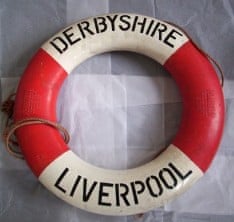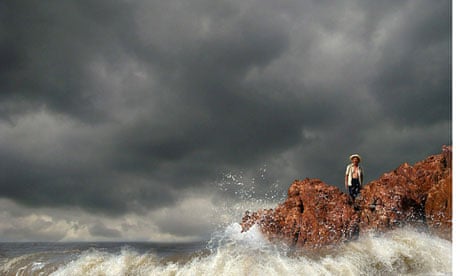A new display at Merseyside Maritime Museum commemorates the MV Derbyshire which, at 91,655 tons, was the largest British ship ever lost at sea.
The Derbyshire was lost with 44 people on board when it ran into a typhoon in the South China Sea in September 1980. At the time, the Conservative government refused to launch a public inquiry into the loss, with trade minister Lord Trefgarne telling the House of Lords in 1981
I have concluded that a court could not reasonably be expected to establish the cause of this casualty.

It took the establishment of the Derbyshire Family Association, which spent many years lobbying, the discovery (two and a half miles under water) of the wreck of the ship in 1994, and a change of government, to get a formal inquiry, which eventually reported in 2000.
The inquiry concluded that a combination of a design fault in the ship and the atrocious weather conditions were responsible for the sinking, and no blame should be attached to the crew. The Derbyshire had vanished without even having time to put out a distress signal, virtually without trace and with no sign of wreckage – although an oil slick was reported in the area by Japanese rescue vessels, and an empty lifeboat was spotted six weeks after the ship sank.

The Derbyshire was built by Swan Hunter at their Haverton Hill yard on Teesside and launched in 1976. It was originally called the MV Liverpool Bridge. It belonged to the Bibby Line, which is a Liverpool-based shipping firm originally established in 1801 as Bibby & Hall. At the time of the sinking she was on her way from Canada to Kawasaki, carrying nearly 160,000 tons of iron ore.
The youngest crew member was 17 year old Adrian Stott, from Macclesfield in Cheshire. It was his first deep sea voyage and his last words to his mother at Manchester airport, when going out to join the ship were
Don't look so worried, mum, I'll be back.
Ellie Moffat, Curator of Maritime Collections, said:
The MV Derbyshire story is one of tragedy and loss. This was a vast ship but she was overcome in minutes during Typhoon Orchid. The Derbyshire story is also about a 20-year campaign by families of those that died to uncover the truth about why the ship sank. We are pleased to be able to tell this important story in the Museum. Some pieces in the display will now become part of our permanent collections.

The Derbyshire Family Association is currently fund-raising for a permanent memorial to the ship to be sited at Liverpool's Pier Head - 17 of the crew who died on the Derbyshire came from the city. Paul Lambert, Chairman of DFA (and brother of Peter Lambert, who died on the ship, aged 19), said:
We are pleased that the story of the MV Derbyshire is being covered in the Museum. It's a very special moment for the families and ensures that the crew who were lost will never be forgotten.
As well as the display, Merseyside Maritime Museum also has an online feature on the sinking of the Derbyshire here.

Comments (…)
Sign in or create your Guardian account to join the discussion